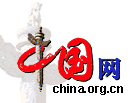In Northwest China's Ningxia Hui Autonomous Region, the Xixia Kingdom (Western Xia, 1038-1227) has a history worth boasting about to world.
The territory of the ancient feudal kingdom established by the Dangxiang people (Tanguts) in the 11th century, overlapped today's Ningxia, as well as some parts of the neighbouring Gansu and Shaanxi provinces and the Inner Mongolia Autonomous Region.
Since 1949, when the People's Republic of China was founded, many precious relics of the Xixia Kingdom have been unearthed. Most of them are now preserved at the Ningxia Museum.
However, the cream of the Xixia cultural relics are now being shown at the National Museum of China in Beijing.
The exhibition, jointly held by the National Museum and the Ningxia Museum, opened yesterday and will run through March 20, 2005.
Short-lived kingdom
The Xixia people led a nomadic life and created a culture very different from the agriculture of the Hans.
Like the Mayans, the prosperous Xixia seemed to fall and disappear suddenly after the fierce Mongolian troops razed it to the ground in 1227, leaving a question mark in the history of world civilization.
But even after more than eight centuries and several changes of dynasties, there remains much evidence that help trace back the ancient glory.
Today the Xixia Mausoleum, located in the suburbs of Yinchuan, the capital city of Ningxia, is the most important historic site of the city and a must-see for tourists.
Even the place name, Ning-xia, has some connection with Xi-xia, as the syllable xia is represented by the same Chinese character.
After being conquered by Mongolian troops, the Xixia culture was severely damaged, with only a few books and other records remaining.
"This exhibition is a precious chance for those who are interested in the history of the mysterious ancient kingdom," said Li Tong, deputy curator of the Ningxia Museum.
The Xixia Kingdom, established by a Dangxiang clan, was short-lived with a history of only 190 years.
According to historians, Dangxiang, or Tanguts, were remnants of the Western Qiang people.
The Qiang people led a nomadic life in ancient times, living mainly on herding sheep.
The Chinese character for sheep and goats, yang, is very similar to the character qiang in grapheme.
In its early years, the Tanguts inhabited the Qinghai area and migrated to the Ningxia-Gansu areas afterwards.
The rise of the Tanguts began in the Sui Dynasty (AD 581-618) and Tang Dynasty (AD 618-907).
Taking long-term control of the Xiazhou local authorities, they gradually raised forces.
In 1038, Li Yuanhao declared the separation from the Song Dynasty (960-1279) and the establishment of Great Xia (Xixia was what the Song Dynasty used to call them) at the eastern end of the ancient Silk Road.
Confronting the dynasties of Song, Liao (916-1125) and Jin (1115-1234) successively, Xixia experienced 10 emperors' reign of 190 years.
From 1205 onward, Mongols, led by the legendary Genghis Khan and his four sons, attacked Tanguts six times and wiped out the regime in 1227.
Occupying the area along the Silk Road, Xixia developed a culture partly influenced by the Han nation but with its own distinguished characteristics.
The current exhibition includes a number of very impressive items that are evidence of the splendid culture of the Xixia Kingdom.
Important records
According to Li Tong, more than two thirds of Xixia's territory are covered by desert. The Yellow River traversed Xixia. The area along the river, namely the Hetao Plain, was once one of China's "farm belts."
"The Tanguts were not only horseback people, they were also in the process of turning into agricultural society," said Li.
This can be proved by a gilded bronze ox, which has been inscribed on China's national treasure list.
The bronze ox weighted 188 kilograms and was unearthed in a Xixia tomb in Yinchuan in 1977.
According to Li, when archaeologists arrived, the tomb had already been robbed. But when one of the excavation team members accidentally kicked the wooden door plank that was removed from the frame and placed on the ground, "a miracle" occurred. The two horns of the bronze ox, which had been buried under the plank, poked out of the plank.
"Relics need to meet at least three requirements to be inscribed on the national treasure list: well-preserved, irreplaceable, and representing the highest level of craftwork at the time it was produced. The ox is fully qualified," Li said.
The excavation team also unearthed a stone horse sculpture from the same tomb.
The exhibition also includes a page of sutra in Xixia characters, which was uncovered in Baisigou Pagoda in the county of Helan in 1991.
The sutra, Li said, is the earliest book printed with wooden movable type so far unearthed in China.
There are also some other works featuring Xixia characters, including stele inscriptions, bronze seals and bronze warrants.
The Tanguts devised their own indigenous ideogrammatic script in the 11th century. It was based on the traditional Chinese characters, but much more complicated.
According to Li, only about 10 per cent of the 7,000 or so Xixia characters has less than 10 strokes.
Characteristics
The most complicated Xixia characters have 48 strokes each.
Because of its complexity, the Xixia characters are called "words from heaven" by historians.
It became a dead language with the down fall of the kingdom, but has already been cracked by today's archaeologists.
With the popularity of their own characters, the Xixia people developed a literary tradition of translated Buddhist texts and original secular works.
"The Tanguts kept a tradition of embracing Buddhism," said Li.
Except sutras, the tradition can also be proved by a unique kind of glazed pottery architecture ornaments, which are in the shape of "sweet-voiced bird" (miaoyin niao).
Called Kalaviuka in Sanskrit, miaoyin niao is a legendary half-man, half-bird figure worshiped in Buddhism. "Visitors will be impressed with these precious relics of Xixia. They present part of the fabulous historic and multi-ethnic cultural heritage of China," Li said.
(China Daily December 21, 2004)

